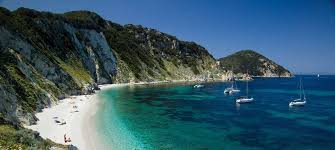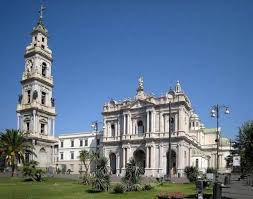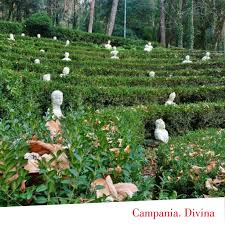We shall be suspending our services during the official period of mourning
for Pope Francis
We are sure that our readers will understand and approve
SAVING PALM SUNDAY PALMS
The “Parmureli”, one of the most characteristic symbols of a Roman Easter, risks disappearing if a determined little beetle continues unchecked on its course of havoc. The voracious palm weevil, which found its way into Italy from the Orient, has successfully destroyed many of the palm trees that grace coastal towns, especially in the Ligurian region where the sweeping fronds of the Phoenix dattifera provide the long branches for the Palm Sunday procession at St. Peter's.
The palm leaves are woven into intricate shapes by local Bordighera and Sanremo horticulturists to form the distinctive “parmureli” banners, symbolizing the triumphant entry of Jesus Christ into Jerusalem a week before his betrayal and death.
The tradition of supplying the Vatican palm leaves dates back to the 16th century. According to a well-known legend it derives from an episode involving the raising of the towering Egyptian obelisk that dominates St. Peter's square. Brought from Heliopolis by Caligula to decorated what was Nero's Circus, it had toppled over and lain abandoned after the circus fell into disuse. When Pope Sixtus V decided to have it raised the complex manoeuvre almost failed when the weight bearing ropes began to fray under the strain. The disaster was averted by a sea captain from Bordighera who shouted instructions to wet the ropes. The Pope expressed his gratitude by according the captain's family the eternal privilege of supplying the palm leaves for the Easter procession – a tradition still kept alive today.
Nowadays, however, in churches all over Italy, the classic palm leaf has been substituted by an olive branch, symbol of peace.
Info: www.compagniadellepalme.eu infopoiny@comunedisanremo.it

WHALE WATCHING AT ELBA
The island of Elba on the coast of Tuscany is best known as the place of confinement of Napoleon in 1814, but it is now making its name as an important centre of Whale Watching and marine ecological research.
The seven islands of the Tuscan Archipelagos, of which Elba is the the biggest, are all part of the Pelago Sanctuary for Marine Mammals, a marine nature reserve that extends for 90,000 sq.km between the coasts of Italy, Southern France and northern Sardinia, that was established in 1999 and hailed as the first International High Seas Marine Park
The area provides the main feeding ground for fin whales in the Mediterranean and Whale Watching boat trips are regularly available from Elba. Sightings of whales, dolphins and other marine mammals are possible all year round, though it is recommended to avoid the high season months when increased human activity and noise disturbs the animals. This month Elba held the 6th edition of the formation course to obtain “High Quality Whale Watching” certification, instituted by the research foundation CIMA (Centro Internazionale Monitoraggio Ambiente CIMA - International Centre of Environmental Control), sustained by the Tuscan Archipelago National Park.
M.STENHOUSE
Info: Tel. +39.02.89054160 www.visitelba.info info@centroricercacetacei.org
 I
I
PISA PROTECTS ITALY'S STREET ART
The University of Pisa has launched a revolutionary scientific project developed after three years of study and experimentation aimed at the conservation of street art. Entitled SuPerStAr (Sustainable Preservation Strategies for Street Art) the team, headed by Prof. Francesca Modugno of the university Chemistry Faculty, has carried out trials on mural paintings all over Italy to develop the best techniques and materials to restore and preserve the wall paintings by various artists that decorate buildings in urban areas.
These paintings, many of which have been created by well-known international artists,
have often been vandalised, scribbled over, or have deteriorated due to exposure to weather conditions.
The team concentrated on iconic works of art, like Keith Haring's “Tuutomondo” dated1989, painted on the wall of the monastery of Sant'Antonio in Pisa, the colossal 1,300 sqm “Necesse”in Milan, created by Italian street artist SMOE to commemorate the victims of the COVID pandemic and works by Alessandro Caligaris e Mauro 149 in Turin, part of Italy's first open air Museum of Urban Art .
M, STENHOUSE
Info: Tel. +39. 050.2212111 www,unipi.it

GORICA-GORIZIA A SYMBOL OF EU UNITY
Once rigidly separated, the border town of Nova Gorica in Slovenia has joined forces with Gorizia in Italy, its “other half”, to promote its new prestigious status as “European Capital of Culture 2025 under the promotional banner of “Go!2025”.
The choice is highly symbolic. The town was split down the middle on the demarcation line drawn up at the end of WWII and throughout the entire Cold War period movement between the two sides was rigidly controlled. Although things gradually relaxed and the frontier fully opened in 2004 with Slovenia's entry into the EU, the city still preserves two distinct characters.
The nomination of Nova Gorica has been hailed as the first “Borderless EU Capital of Culture”. Although the title of EU Capital of Culture 2025 is held officially by the Slovenian township together with Chemnitz in Germany, its Italian half is participating fully in the year-long cultural programme packed with events and exhibitions, making this a “first” involving two separate countries.
M. STENHOUSE
Info: www.go2025.eu
Infopoint Promo Turismo FVG, Gorizia - Tel. +39.0481.535764

“MODERN” POMPEII MASTERPIECE DISCOVERED
There is more to Pompeii than the excavated city dug out of the disaster of the long ago eruption of Vesuvius. Pompeii is also a modern city, part of the “Metropolitan City of Naples” and with over 23,000 inhabitants. It is also a major religious destination drawing 4 million Roman Catholic pilgrims every year to the celebrated shrine of the Beata Vergine Maria del Santo Rosario di Pompei (the Blessed Virgin Mary of the Holy Rosary of Pompeii).
It now has an additional attraction for art lovers, with the recent surprise discovery of a long-lost Andrea Mantegna masterpiece of the “Deposition of Christ.” The painting, which was very badly damaged, was barely recognizable when it came to light stacked in an obscure corner of the church, where, for unknown reasons, it had been trasferred from the Basilica of San Domenico in Naples and forgotten.
The painting is now in the Vatican Museum, where it is being cleaned and restored by experts. It will be on public view for the next few months before it is returned to its “adopted” home in the Pompeii sanctuary, where it will be permantently exhibited in a special room along with 12 other paintings of the Neapolitan School of the 17th and 18th centuries.
Info: Tel. +39.081.8577371 www.santuario.it

FAI REOPENS THEATRE OF VERDURE
The Annual spring weekend (21st-23rd April 2025) of FAI (Fondo Ambiente Italiano – Italian Heritage Foundation), the Italian branch of the International National Trusts Organization for heritage preservation, offered the customary opportunities for art and culture lovers to visit many special protected cultural sites not normally available to the public.
Among those was the rarely open 18th century Villa d'Ayala Valva near Salerno (Campania), a 44 acre estate, that has been dubbed the “Versailles of Campania” due to its magnificent Italian gardens. The villa was gifted to the Knights of Malta by the last remaining heir of the D'Ayala Valva dynasty.
One of its most fascinating features is the Teatro di Verzura (Theatre of Verdure), an open air auditorium immersed in Nature and largely covered in shrubs and plants and decorated with sculptures and fountains, which was used for summer performances to entertain the marquise's guests.
These little known outdoor theatres were once a frequent feature in the gardens of noble families. 18 of these are listed in Italy as having survived. The oldest in Europe is believed to be the 17th century Royal Villa of Marlia in Tuscany, treasured and restructured by Napoleon's sister, Elisa Bonaparte Bacliocchi, while she was Grand Duchess of Tuscany.
The 2025 FAI Spring Weekend saw the exceptional opening to the public of 750 sites, many of which are normally closed to the public.
Info: www.fondoambiente.it

EASTER SKY OF KITES AT CERVIA
Indonesian artist, sculptor and kite master Kadek Armika is the guest of honour at this year's Artevento spring festival in Cervia (Emilia Romagna) where his works will be on show under the title “Balance and Harmony” in the Magazzino del Sale (the former Salt Warehouse) exhibition centre. The show previews the spectacular sight of hundreds of kites, flown by kite designers and enthusiasts from all over the world during the annual Artevento Cervia festival that runs for the entire period of the spring holiday (19 April – 4 May 2025).
The event takes on a special meaning this year as it celebrates its 45th edition and focusses on the theme of a message of peace.
The town of Cervia on the Po Delta, has been celebrated for hundreds of years for its naturally pure salt production, appreciated not only in gastronomy but also in beauty treatments and known as “the White Gold of the Adriatic.” Cervia sits on a vast park of over 2,000 acres containing 50 lagoons, woodlands and a 16 km-long canal. The Cervia Park is a recognized ecological centre for wetland conservation and wild life. Organized boat trips are available to view rare birds like flamingos, black-winged stilt birds and great egrets.
Info: Tel. +39.051.6569105 info@culturaliart.com https://artevento.com

TUSCANY'S OCTOPUS HAVEN
The Gulf of Talamone at Orbetello (Tuscany) is the site chosen for the first Italian octopus protected area. The project, set up by a team of scientists and environmentalists operates under the name OCTOPOLIS in collaboration with the Science and Environmental Department of the University of Siena, aims to create safe “houses” for an octopus colony in specially designed clay pots which rest on the seabed and cannot be caught up in fishermen's nets.
Octopuses are constantly caught in drag fishing nets and killed. Global warming of the Mediterranean has also seriously depleted their numbers, due to changes in the marine ecosystem and pollution. The Octopolis project also aims to make the public more aware of the unique qualities of these fascinating marine creatures which have highly developed brains that allow them to solve problems and interact with each other.
The Casa dei Pesce (House of Fish), a non-profit association, founded in 2012 to monitor marine life in the Mediterranean is also involved. Inspired by local activist Paolo Fanciulli, better known as “Paolo il Pescatore”,(Paolo the Fisherman), who stopped illegal drag net fishing in the Orbetello coastal waters by submerging large stone blocks on the seabed. Soon local sculptors began to donate their works to the cause, thus creating an underwater museum with 44 art works, that can be admired by divers.
The Octopolis Project has set up a crowdfunding appeal to help finance further research.
M. STENHOUSE
Info: Tel. +39. 3444071412 https://casadeipesci.it info@casadeipesci.it
<< Previous 1 2 3 4 5 6 7 8 9 10 11 ... 13 ... 15 ... 17 ... 19 ... 21 ... 23 ... 25 ... 27 ... 29 ... 31 ... 33 ... 35 ... 37 ... 39 ... 41 ... 43 ... 45 ... 47 ... 49 ... 51 ... 53 ... 55 ... 57 ... 59 ... 61 ... 63 ... 65 ... 67 ... 69 ... 71 ... 73 ... 75 ... 77 ... 79 ... 81 ... 83 ... 85 ... 87 ... 89 ... 91 ... 93 ... 95 ... 97 ... 99 ... 101 ... 103 ... 105 ... 107 ... 109 ... 111 ... 113 ... 115 ... 117 ... 119 ... 121 ... 123 ... 125 ... 127 ... 129 ... 131 ... 133 ... 135 ... 137 ... 139 ... 141 ... 143 ... 145 ... 147 ... 149 ... 151 ... 153 ... Next >>



